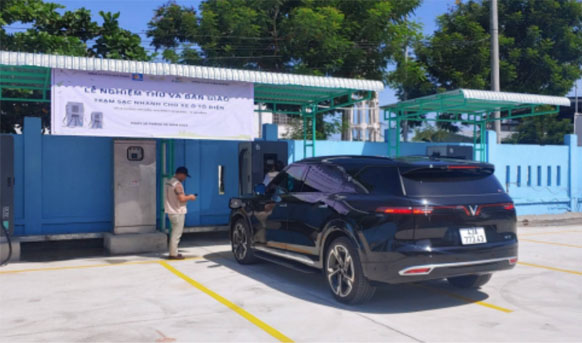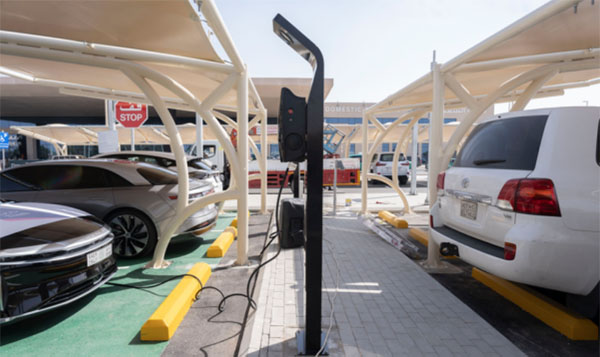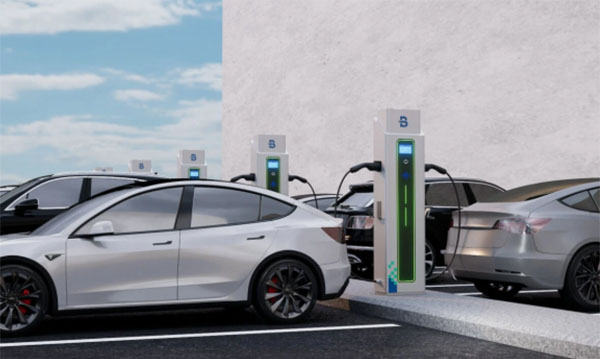Best Tips to Ensure Electric Vehicle Safety in Extreme Hot and Cold Weather
By Space Coast Daily // July 5, 2024
As summer approaches, electric vehicles face a series of challenges under extreme temperature conditions. In high-temperature environments, EV batteries and electrical systems are prone to overheating.
It affects electric vehicle safety and charging efficiency and may also accelerate batteries’ degradation.
In extremely low temperatures, on the other hand, the slowing down of chemical reactions in batteries can result in decreased charging speed. Besides, improper charging practices in hot or cold weather accelerate equipment degradation.
Considering these, EV owners and charging station operators need to take the necessary measures to ensure electric car charging safety and maintain battery life. This article discusses several electric vehicle charging safety guidelines in extreme hot and cold weather. Read on to learn more!

How to Ensure Electric Vehicle Safety in Extreme Weather
There are several recommended practices for EV owners to safely operate their vehicles during hot and cold conditions. The following are key electric vehicle charging safety guidelines:
- Extremely Hot Weather
In the past few years, record-high temperatures in summer around the world have led to forest fires and severe droughts in certain regions.
Given that extremely high temperatures can cause EV batteries to age faster than usual, electric vehicle owners have raised an urgent need for guidelines on how to maintain electric vehicle safety and operational efficiency in hot weather.
1) The Impact of Hot Weather on EV Charging
Extremely high temperatures can negatively affect various aspects of EV charging and electric car charging safety. Here are some EV charging problems in hot weather:
- Surge in Power Grid Pressure
When the weather is very hot, power usage usually goes up. This is because air conditioning or other refrigeration equipment in many places is turned on to keep cool. The electricity consumption of air conditioning in offices and homes has become the main energy demand.
It will put a lot of pressure on the power grid. The increased power demand may affect the stability of EV charging and can also overload and strain the power infrastructure if not adequately prepared.
- Reduced Battery Performance
The chemical reactions inside EV batteries are accelerated when exposed to extreme temperatures over extended periods. This quicker reaction rate adversely impacts battery performance and electric vehicle safety.
How does hot weather affect EV range? Heat speeds up the battery’s internal aging process, lowering its usable capacity and range over charging cycles. The extra stress from continual hot operating temperatures also tends to decrease an EV battery’s lifespan more rapidly. Maintaining optimal battery health is crucial for maximizing an electric vehicle’s value over time.
- Limited Charging Speed
In order to prevent overheating issues and ensure EV charging safety, the car’s battery management system will limit EV charging speed. It automatically lowers the permitted maximum charging power for the batteries during a hot summer, helping reduce the heat generated inside the batteries during the charging process.
Thus, reduced charging power can slow down how quickly the batteries can replenish power. The delayed charge speeds decrease overall charging convenience and increase charging durations for electric cars in hot weather, which is an important consideration for EV owners in warmer climates.
- Overheating of EV Charging
Firstly, high-temperature exposure to sunlight can increase the internal pressure of the battery. If charged immediately at this time, it is easy to exacerbate battery dehydration and bulging and even cause cracking and deformation. In severe cases, it may lead to EV fire accidents.
Secondly, not only will the battery be damaged, but public charging devices such as cables and plugs may also age and be damaged due to high temperatures, increasing safety risks during the charging process.
Issues like equipment malfunctions or failures could then endanger electric vehicle safety. They could also decrease driver safety and convenience.
2) How to Ensure Electric Vehicle Safety in Hot Weather
Charging EV in hot weather without compromising electric vehicle safety demands careful planning when temperatures rise. Diligent car owners can confidently tackle heat waves during their electric rides by implementing sensible measures. Here are some recommended EV charging tips:
- Avoid Direct Sunlight
Leaving electric vehicles parked outside in direct sunlight for extended periods has negative impacts on battery temperatures. The batteries heat up substantially without any shade coverage.
Parking and charging under places like carports and garages helps regulate temperatures inside EVs. This is beneficial, especially when compared to completely unprotected outdoor exposure.
Additionally, it is also recommended to charge EVs outdoors in cool mornings or evenings. It assists in maintaining batteries at more moderate temperature levels.
These simple steps can avoid overheating from solar irradiation and maintain optimal battery longevity and electric vehicle safety in the long run.
- Monitor the Charging Process and Battery Status
Real-time monitoring of battery temperature, voltage, and current during the charging process through EV charging management software ensures a safe and controllable charging process. This is particularly crucial for charging EV in hot weather.
Tracking the session status in real-time avoids big problems if temperatures rise too high or the current drops unexpectedly.
Mobile apps also typically present battery health metrics that reveal degradation risks. Staying aware of battery reactions aids in safe EV charging completion without the risk of overheating damage.
- Limit Charging Speed
In summer, car owners can try to avoid using fast charging mode in hot outdoor environments. Choosing AC charging can reduce the heat generated in the battery and reduce the risk of overheating.
Additionally, slower nighttime home charging provides more time for dissipating built-up internal heat. Gradually, this moderate charging mode enhances electric vehicle safety and protects battery lifespans while still supporting hot weather driving.
- Avoid Charging to Maximum Capacity
In summer, pay attention to avoid completely depleting the car battery, and the charging level should be appropriately controlled to avoid being fully charged every time. This can reduce the pressure and heat accumulation of the battery at high battery levels.
It is far preferable to operate between the 20–80% state of charging to maximize the number of stress-free charge periods while simultaneously reducing wear.
- Check Charging Equipment Before Charging
Before connecting your EV to the charger, it is recommended that you take some moments to inspect for any potential issues, such as the integrity of both the charge connectors attached to the vehicle and the charging unit.
You should also check whether the cooling system is working properly. These quick inspections will allow the identification and resolution of faults to preserve safety.
Under the relentless sun, components bear more pressure. Routine visual checks help catch signs of deterioration early on, ensuring safe EV charging.

- Extremely Cold Weather
Similarly, extreme cold weather can potentially reduce the range of electric vehicles. Like smartphones, electric vehicles also exhibit issues such as reduced battery levels or difficulty starting in low-temperature environments. Issues such as reduced battery range, decreased power during the night, and slower charging speeds are the most concerning topics for car owners.
1) The Impact of Cold Weather on EV Charging
Cold weather poses distinct challenges to EV charging operations and performance. Cold slows chemical reactions inside batteries, extending charging durations.
Keeping these components and the battery at a warm, safe operating temperature is critical. They help ensure electric vehicle safety and reliable driving, even in the harshest seasonal conditions. The following are EV charging issues in cold weather:
- Reduced Battery Efficiency
At extremely low temperatures in winter, the rate of internal chemical reactions inside EV batteries slows down substantially. At freezing or sub-zero levels, there is less energy available to drive electric cars compared to moderate conditions.
As a result, it decreases the quantity of usable energy in the battery at cold temperatures. This translates to lower available power output and storage capacity.
- Slow Charging Speed
Firstly, from the perspective of the chemical reactions inside the battery, low temperatures can cause an increase in the viscosity of the electrolyte inside the battery, which limits the movement speed of lithium ions in the electrolyte and slows down the charging speed.
Secondly, under low-temperature conditions, the internal resistance of the battery will increase, resulting in more energy being converted to thermal energy during charging rather than being converted into chemical energy by the battery.
Finally, to prevent potential battery damage or safety issues caused by low-temperature charging, the battery management system may automatically reduce the charging current.
- Reduced Battery Range
In winter, the frequency of using air conditioning to stay warm inside the car increases significantly. The consumption of battery energy for heating the vehicle results in a decrease in the energy required to drive the vehicle, which generally affects the range during the winter.
Furthermore, a low-temperature environment slows down the chemical reactions inside the battery, increases the internal resistance of the battery, and thus causes the phenomenon of a decreased battery level.
- EV Charging Station Damage
If EV charging stations are left continually exposed to blizzards, floods, or severe cold over the long term without protection, damage risks increase for chargers, cables, and connecting components. Harsh winter weather speeds up degradation.
Ice formation around the EV chargers makes them fail to deliver power safely. In cold weather, its maintenance becomes more difficult, and the repair time may be extended, affecting the user’s charging experience.
- Heating Requirements in Winter Affect the Stability of the Power Grid
Compared to milder seasons with less demand, winter brings peak loads to residential and commercial building spaces. The demand for heating houses proposes more electricity supply demand for utilities.
During winter, the peak electricity consumption period may become more concentrated, which may result in less electricity being allocated to EV charging during specific periods.
2) How to Ensure Electric Vehicle Safety in Cold Weather
During the winter, EV owners need to adopt protective practices to solve EV charging problems in cold weather. From thoroughly inspecting devices to gently warming batteries before charging, several precautions exist.
They protect against thermal damage while simultaneously preserving electric vehicle safety and expected driving ranges. Key strategies and tips include:
- Warming the Vehicle Before Charging
Warming the electric vehicle’s battery and inner spaces approximately 15–30 minutes before charging is beneficial. Preheating the vehicle can increase the battery temperature, thereby enhancing battery activity. The warm temperature is appropriate for efficient charging.
A gradual thermal increase supports the smooth replenishment of battery capacity. It doesn’t impose risks to freezing battery components that are not ready to immediately receive high charging currents.
- Avoid Full Discharge
Leaving at least a 20% state of charge reserve after each drive prevents completely draining the battery under cold conditions. A battery with remaining power allows quicker replenishment compared to a nearly empty battery.
In addition, a battery with remaining power can prevent excessive discharge of the battery at low temperatures and prevent permanent loss of battery capacity.
- Immediately Use it After Charging
After the battery is fully charged, it’s better to immediately drive the electric car instead of parking in a cold garage until needed. Immediately using the car after a fully charged cycle is beneficial. The heat generated during driving can help maintain battery temperature and reduce the impact of low temperatures on battery performance.
- Check If the EV Charging Station Works Correctly
In cold weather, EV charging facilities may be damaged due to freezing, snow accumulation, and other issues. It is important to ensure that the charging station operates properly to avoid damaging the vehicle or battery.
For home chargers, regularly inspecting and maintaining charging equipment is essential. It includes charging stations, cables, and connecting components, ensuring their safe operation when you need them.
How to Improve EV Charging Facilities to Ensure EV Charging Safety
In order to ensure electric vehicle safety for operators and households, the following measures can be taken to improve electric vehicle charging facilities:
- Reasonable Layout and Planning of EV Chargers
Reasonably designing the layout of charging infrastructure helps optimize both usability and weather resilience. Due to the high grid pressure in hot and cold weather, when planning charging stations, it is advisable to avoid excessive density of charging stations that may affect charging speed and user experience.
Carports or other shelters efficiently shade the chargers and electric vehicles. This is an effective way to avoid battery overheating in the summer.
Consider the location of charging stations to ensure they are easy to access while avoiding setting them up in areas susceptible to floods or extreme weather.
- Equipment Quality and Maintenance
High-quality EV chargers with robust casings, ventilation, and a high IP rating are valuable. It helps withstand significant temperature swings and weathering over prolonged exposure.
Regular maintenance of charging equipment can promptly identify and repair potential safety hazards, preventing situations where no charging stations are available. Together, quality EV chargers and preventative maintenance provide long-term availability.
- Intelligent Management
Remote monitoring systems integrated with charging station hardware are crucial. They record real-time updates on utilization, equipment health, energy usage, and environmental data and give feedback to EV charging station operators.
The EV charging management software provides early warnings on potential faults to proactively dispatch maintenance as needed. Fault logging aids continuous design upgrades.
Overall, intelligent oversight streamlines operations while minimizing service disruptions critical to supporting widespread EV adoption.

- Meet Safety Installation Standards
Operators or households should ensure that charging stations comply with electrical safety regulations and building standards when installing them. Hire professionals, as they possess the necessary skills and knowledge.
Installing overload protection devices, such as fuses and circuit breakers, can prevent the risk of fire caused by overload.
Finally, ensure that the charging station has sufficient fire-fighting facilities, such as fire extinguishers, and regularly check their effectiveness.
Where to Buy Reliable EV Chargers?
EVB Charger is an established brand committed to smart EV charging infrastructure. Their products can operate normally in hot and cold weather and still maintain high efficiency, as they provide:
- Intelligent charging management software: EV-SAAS and Z-BOX software provides various functions during the charging process, such as charging session initiation, payment processing, real-time monitoring, remote control, data recording, fault monitoring, etc. It ensures that the charging process is in an optimal state.
- Temperature monitoring: The software can detect the temperature of charging devices and batteries in real time to prevent safety hazards caused by high temperatures. In extreme weather conditions, this feature is very helpful for both drivers and operators.
- High IP level: The EV charger has excellent dust and water resistance. It provides good protection for charging facilities.
- Multiple protection functions: The EV charger is equipped with various protection functions such as overvoltage, overcurrent, leakage, short circuit, overheating protection, etc. In abnormal situations, it can automatically disconnect the power to avoid damage to the vehicle and its users.
One of their recommended products is the Floor-mounted AC EV Charger. It’s a durable and intelligent device suitable for various installations. Some of its key features include:
- Two 22kW charging cables
- A 5-inch LCD screen provides real-time power information during charging sessions.
- Utilize backup power to unlock the charging cable.
- Reliable protection systems include overcurrent, overheating, grounding, leakage, undervoltage, and lightning production. It utilizes various sensors and controls to prevent damage from abnormal operating temperature levels or excessive power flow.
- Weather-resistant outer casing with an IP54 rating. It facilitates charging outdoors or in covered areas during light rain or dust events while protecting internal components.
- Internal temperature tracking sensors monitor the operating temperature of batteries, cables, and power electronics, especially during hot weather.
- Certified by key international EV charging standards such as UL, CB, CE, UKCA, and others to ensure dependable operation.

Conclusion
As EVs become more popular, ensuring their safe use during extreme weather is important. This requires EV charging tips from both owners and operators. Regular battery care, smart charging habits, and rigorous facility management can help mitigate risks. With renewable integration growing worldwide, stable EV adoption is also crucial for grid reliability.
EV charging solution providers like EVB Charger aim to develop resilient products through constant innovation. They recognize that prioritizing safety delivers confidence for further promoting electrified transportation. Visit the company’s website to browse all of its innovative offerings.












